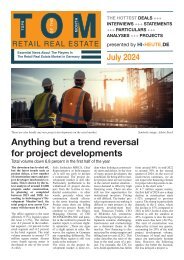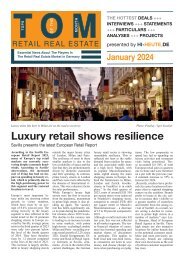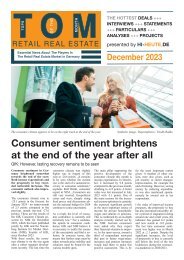TOM 04 2024
You also want an ePaper? Increase the reach of your titles
YUMPU automatically turns print PDFs into web optimized ePapers that Google loves.
Page 11 T O M<br />
CENTERS April <strong>2024</strong><br />
From mixed-use to events, many shopping centers are looking for concepts to position themselves for the future.<br />
<br />
Symbolic image: Unsplash / Krisztina Papp<br />
Shopping centers reposition themselves<br />
White paper sheds light on the situation of the asset class<br />
Shopping centers find themselves<br />
in a challenging competitive<br />
environment. Global<br />
crises and war situations are<br />
driving up costs, unsettling<br />
customers and resulting in a<br />
reluctance to spend while at<br />
the same time reducing rental<br />
income.<br />
Despite the difficult waters,<br />
center managers are trying to<br />
develop solutions to make their<br />
centers fit for the future. Mixeduse<br />
is already a proven trend, as<br />
are measures such as increased<br />
and cost-saving energy efficiency<br />
and attractive events.<br />
Decline in rental<br />
volume<br />
„Of course, these can be sensible<br />
measures to combat vacancies<br />
and declining visitor frequency.<br />
However, it is impressive to see<br />
the different lines of development<br />
that are emerging in shopping<br />
centers,“ says EHI study<br />
author and retail real estate expert<br />
Lena Knopf, explaining the<br />
results of the white paper „Center<br />
Management in Focus“ by<br />
EHI and GCSP.<br />
In a clear majority of around<br />
two thirds of centers, the rental<br />
volume (excluding ancillary<br />
costs) declined between 2021<br />
and 2023. The two main reasons<br />
for this are subsequent lettings<br />
with lower rents to retailers and<br />
rent reductions on existing contracts.<br />
Events increase<br />
attractiveness<br />
Only in the more recent centers<br />
built after 2010 did the proportion<br />
with increased rental income<br />
outweigh the proportion<br />
with decreased rental income.<br />
The centers with retail space of<br />
between 30 and 40,000 square<br />
meters performed the worst.<br />
The smallest centers with ten to<br />
20,000 square meters of retail<br />
space performed best, with the<br />
lowest proportion of decreased<br />
rental income and the highest<br />
proportion of increased rental<br />
income. Increased mixed-use<br />
concepts such as leisure facilities<br />
or medical services are attracting<br />
new tenants to shopping<br />
centers.<br />
Events are an established measure<br />
to increase the attractiveness<br />
of a shopping center and<br />
strengthen customer loyalty.<br />
Seasonal occasions such as<br />
Christmas or Easter (93%) promise<br />
the greatest success, followed<br />
by fun events suitable for<br />
families (73%). Overall, many<br />
centers (43%) are organizing<br />
fewer events than before the<br />
pandemic or the same number<br />
(46%). The larger centers are in<br />
the lead. The smaller the center,<br />
the more difficult it is to host<br />
many successful events. Every<br />
second small center under<br />
20,000 square meters reduces<br />
the number of events, but only<br />
around one in three large centers<br />
with 40,000 square meters<br />
or more.<br />
Frequency and<br />
turnover<br />
Visitor frequency - often measured<br />
using video, light or laser<br />
technology - has fallen in 54%<br />
of shopping centers compared<br />
to the pre-coronavirus level in<br />
2019, but 30% have observed<br />
a constant frequency and only<br />
16% are happy about more customers.<br />
However, retail sales<br />
are looking slightly better. At<br />
35%, they are higher or even<br />
significantly higher, and at 29%<br />
they are at a similar level - even<br />
though this growth is currently<br />
accompanied by relatively high<br />
inflation rates, which means that<br />
many retail sectors have been<br />
able to increase their sales in<br />
nominal terms but not in real<br />
terms.<br />
Often moderate<br />
vacancy rate<br />
More than half of the centers<br />
(57%) have a moderate vacancy<br />
rate of up to 5% of the retail rental<br />
space. A good third (34%) of<br />
centers even have a low vacancy<br />
rate of up to 3% this year, although<br />
this was almost twice as<br />
many (66%) in 2019. The proportion<br />
of centers with vacancies<br />
of more than five percent<br />
has more than doubled from 19<br />
percent in 2019 to 44 percent in<br />
<strong>2024</strong>.
















